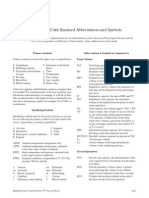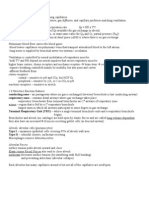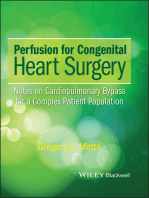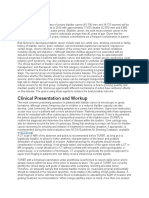Symbols PDF
Symbols PDF
Uploaded by
SunilKumarCopyright:
Available Formats
Symbols PDF
Symbols PDF
Uploaded by
SunilKumarOriginal Title
Copyright
Available Formats
Share this document
Did you find this document useful?
Is this content inappropriate?
Copyright:
Available Formats
Symbols PDF
Symbols PDF
Uploaded by
SunilKumarCopyright:
Available Formats
RESPIRATORY CARE Standard Abbreviations and Symbols
Editor’s Note: This compilation is adapted from the recommendations of the American Physiological Society and the
ACCP-ATS Committee on Pulmonary Nomenclature. Some additions have been made.
Primary Symbols Abbreviations & Symbols in Common Use
Primary symbols are denoted by upper case, or capital letters. Lung Volumes
C Compliance S Saturation in the blood TLC Total lung capacity: the volume in the lungs at
D Diffusing capacity phase maximal inflation
F Fractional concentration t Time RV Residual volume: the volume of air remaining
of a gas T Temperature in the lungs after a maximal exhalation
P Pressure V Gas volume ERV Expiratory reserve volume: the maximal
q Blood flow X Any variable volume of air that can be exhaled from the
–
Q Blood volume X Mean value end-expiratory position
IRV Inspiratory reserve volume: the maximal vol-
A bar over a primary symbol denotes a mean or averaged value; ume that can be inhaled from the end-inspira-
for example, x is a mean pressure. A dot over a primary sym- tory level
bol denotes a time derivative, for example, y is dV/dt, or flow. IC Inspiratory capacity: the sum of IRV and TV
The second derivative, with respect to time, is denoted by two IVC Inspiratory vital capacity: the maximum
dots above the primary symbol, for example, V̈is d2V/dt2, or volume of air inhaled from the point of maxi-
acceleration. mum expiration
VC Vital capacity: the volume equal to TLC − RV
Qualifying Symbols
VT Tidal volume: that volume of air moved into
or out of the lungs during quiet breathing
Qualifying symbols may be denoted by characters of regu-
(VT indicates a subdivision of the lung;
lar size following the primary symbol or by subscripted char-
when tidal volume is precisely measured, as
acters—depending on printing capabilities.
in gas exchange calculation, the symbol VT
A Alveolar I Inspired or VT is used.)
B Barometric L Lung FRC Functional residual capacity: the volume in
D Dead space; wasted ventilation T Tidal the lungs at the end-expiratory position
E Expired RV/TLC% Residual volume expressed as percent of TLC
VA Alveolar gas volume
ATPD Ambient temperature and pressure, dry VL Actual volume of the lung including the
ATPS Ambient temperature and pressure, saturated volume of the conducting airways
with water vapor at these conditions
BTPS Body temperature and pressure, saturated with Forced Spirometry
water vapor at these conditions
STPD Standard conditions: temperature 0 dC (273 dK), FVC Forced vital capacity: the determination of the
pressure 760 torr and dry vital capacity from a maximally forced expira-
tory effort
a Arterial est Estimated FEVt Forced expiratory volume (time): a generic
an Anatomic max Maximal term indicating the volume of air exhaled
b Blood, in general rb Rebreathing under forced conditions in the first t seconds
c Capillary v Venous FEV1 Volume that has been exhaled at the end of
ć Pulmonary end-capillary f Mixed venous the first second of forced expiration
RESPIRATORY CARE • JUNE ’97 VOL 42 NO 6 637
SI UNITS, ABBREVIATIONS, & SYMBOLS
FEFx Forced expiratory flow related to some PL Transpulmonary pressure
portion of the FVC curve; modifiers refer to Ppl Intrapleural pressure
amount of FVC already exhaled Ptm Transmural pressure, pertaining to an airway
FEFmax The maximum instantaneous flow achieved or blood vessel
during a FVC maneuver PImax Maximal inspiratory pressure; this term is
FEF25-75% Forced expiratory flow over the middle half of often symbolized as MIP
the FVC, that is, the average flow from the PEmax Maximal expiratory pressure; this term is
point where 25% of the FVC has been exhaled often symbolized as MEP
to the point where 75% has been exhaled. This R Resistance (ie, pressure per unit flow)
–
formerly has been called the maximal midex- R Mean total resistance ([RI + RE] ÷ 2)
piratory flow rate (MMEFR). Raw Airway resistance
FIF Forced inspiratory flow: (Specific measure- RE Total expiratory resistance measured by
ment of the forced inspiratory curve is esophageal balloon method
denoted by nomenclature analogous to that for RI Total inspiratory resistance measured by
the forced expiratory curve. For example, esophageal balloon method
maximum inspiratory flow is denoted FIFmax. RL Lung resistance
Unless otherwise specified, volume qualifiers WOB Work of breathing
indicate the volume inspired from RV at the
point of measurement.)
Blood Gas, Acid-Base, &
PEF The highest forced expiratory flow measured
with a peak flow meter Gas Exchange Terms
MVV Maximal voluntary ventilation: volume of air
expired in a specified period during repetitive PaO2 Arterial oxygen tension, or partial pressure
maximal effort PAO2 Alveolar oxygen tension, or partial pressure
PaCO2 Arterial carbon dioxide tension, or partial
pressure
Ventilation
PACO2 Alveolar carbon dioxide tension, or partial
pressure
f Breathing frequency (breaths/minute or
breaths/min) PfO2 Oxygen tension of mixed venous blood
yA Alveolar ventilation/min P(A-a)O2 Alveolar-arterial oxygen tension difference.
yD Physiologic dead space ventilation/min The term formerly used (A-a DO2) is discour-
yE Expired volume/min; VE is exhaled volume/ aged.
breath P(a/A)O2 Alveolar-arterial tension ratio; PaO2 : PAO2.
yCO2 Carbon dioxide production/min corrected for We propose the term oxygen exchange index
STPD conditions to describe this ratio.
yO2 Oxygen consumption/min corrected for STPD C(a-v)O2 Arteriovenous oxygen content difference
conditions SaO2 Oxygen saturation of the hemoglobin of
arterial blood
Pulmonary Mechanics SpO2 Oxygen saturation as measured by pulse
oximetry
Cdyn Dynamic compliance: compliance measured CaO2 Oxygen content of arterial blood
at point of zero gas flow at the mouth during pH Symbol relating the hydrogen ion concentra-
active breathing tion or activity of a solution to that of a stan-
Cst Static compliance: compliance measured dard solution; approximately equal to the
under conditions of prolonged interruption of negative logarithm of the hydrogen ion con-
airflow centration. pH is an indicator of the relative
E Elastance: the reciprocal of compliance acidity or alkalinity of a solution.
Gaw Airway conductance: the reciprocal of Raw
sGaw Airway conductance at a specific lung volume Blood Flow and Shunts
Paw Pressure in the airway; further modifiers to be
specified Q Blood volume
PA Alveolar pressure q Blood flow (volume units and time must be
Pes Esophageal pressure used to estimate Ppl specific)
638 RESPIRATORY CARE • JUNE ’97 VOL 42 NO 6
SI UNITS, ABBREVIATIONS, & SYMBOLS
Qc Pulmonary capillary blood volume SI Units with Abbreviations
Qsp Physiologic shunt flow (total venous
admixture) SI units are decimal units of measurement for physical prop-
qsp/qtot Shunt as percent of total blood flow erties and quantities that have been adopted by the scientific
community worldwide. The reader is referred to Respir
Diffusing Capacity Care 1988;33:861-873, Respir Care 1989;34:145, and
Respir Care 1997;42(6):639-640 for more information.
DLCOsb Diffusing capacity of the lung for carbon
Variable Unit Abbreviation
monoxide determined by the single-breath temperature kelvin K
technique length meter m
Dm Diffusing capacity of the alveolocapillary mass kilogram kg
membrane (STPD) time second s
D/VA Diffusion per unit of alveolar volume, with D pressure pascal Pa
at STPD and VA in liters BTPS work, or energy joule J
Système International:
Examples of Conversions Commonly Used in Respiratory Physiology and Respiratory Care
Physical Known Desired
Example of Conversion Calculation
Quantity Unit Unit
0.4536 kg
Force (or mass) lb kg 150 lb M 1 lb = 68 kg
1 lb
kg lb 68 kg M 0.4536 kg = 150 lb
0.1333 kPa
Pressure torr kPa 35 torr M 1 torr = 4.7 kPa
1 torr
kPa torr 4.7 kPa M 0.1333 kPa = 35 torr
70.31 cm H2O 0.7355 torr
psi torr 1.0 psi M 1 psi M 1 cm H O = 52 torr
2
1 cm H2O 1 psi
torr psi 51.72 torr M 0.7355 torr M 70.31 cm H2O = 1.0 psi
0.09806 J 1 kg t m
Work L t cm H2O kg t m 20 L t cm H2O M 1 L t cm H O M = 0.2 Kg t m
2 9.807 J
1 kg t m 1 L t cm H2O
J L t cm H2O 2 J M 9.807 J M 0.01 kg t m = 20 L t cm H2O
0.1634 W
Power kg t m t min−1 W 2.5 kg t m t min−1 M 1 kg t m t min−1 = 0.41 W
1L 10.20 L t kPa−1
Compliance mL/cm H2O L/kPa 100 mL t cm H2O M 1000 mL M 1 L t cm H O−1 = 1.02 L t kPa−1
2
0.090806 kPa t L−1
Resistance cm H2O t s t L−1 kPa t s t L−1 55 cm H2O t s t L−1 M 1 cm H O t s t L−1 = 5.4 kPa t s t L−1
2
Note: Retain all digits during computation to avoid roundoff error. However, the least precise measurement used in a calculation determines the number of significant digits
in the answer. Thus, the final product or quotient should be written with the same number of significant figures as the term with the fewest significant figures, as shown in the
examples above. The least ambiguous method of indicating the number of significant figures is to write the number in scientific notation. For example, the number 30 may
have either one or two significant figures, but written as 3.0 M 101, it is understood that there are two significant figures. For more information about scientific notation,
significant figures, and rounding off, see Lough MD, Chatburn RL, Shrock WA, Handbook of respiratory care. Chicago: Yearbook Medical Publishers, 1985:170-173.
RESPIRATORY CARE • JUNE ’97 VOL 42 NO 6 639
SI UNITS, ABBREVIATIONS, & SYMBOLS
Système International:
Conversion Factors for Units Commonly Used in Medicine
Physical Quantity Conventional Unit SI Unit Conversion Factor*
Length inch (in.) meter (m) 0.025 4
foot (ft) m 0.304 8
Area in.2 m2 6.452 M 10−4
ft2 m2 0.092 90
Volume dL (= 100 mL) L 0.01
ft3 m3 0.028 32
ft3 L 28.32
fluid ounce mL 29.57
Amount of substance mg/dL mmol/L 10/molecular weight
mEq/L mmol/L valence
mL of gas at STPD mmol 0.044 62
Force (weight) pound (lb) newton (N) 4.448
dyne N 0.000 01
kilogram-force N 9.807
pound kilogram-force 0.453 6
ounce gram-force 28.35
Pressure cm H2O kilopascal (kPa) 0.098 06
mm Hg (torr) kPa 0.133 3
pounds/in.2 (psi) kPa 6.895
psi cm H2O 70.31
cm H2O torr 0.7355
standard atmosphere kPa 101.3
millibar (mbar) kPa 0.100 0
Work, energy kg t m joule (J) 9.807
L t cm H2O joule (J) 0.098 06
calorie (cal) joule (J) 4.185
kilocalorie (kcal) J 4 185
British thermal unit (BTU) — 1055
Power kg t m t min−1 watt (W) 0.163 4
Surface tension dyn/cm N/m 0.001
Compliance L/cm H2O L/kPa 10.20
Resistance cm H2O t s t L−1 kPa t s t L−1 0.098 06
cm H2O t min t L−1 kPa t s t L−1 5.884
Gas transport (ideal gas, STPD) mL t s−1 t cm H2O−1 mmol t s−1 t kPa−1 0.455 0
Temperature dC dK dK = dC + 273.15
dF dC dC = (dF − 32)/1.8
dC dF dF = (1.8 t dC) + 32
*To convert from conventional to SI unit, multiply conventional unit by conversion factor. To convert in the opposite direction, divide by conversion factor. Examples:
10 torr = 10 M 0.133, 3 kPa = 1.333 kPa, 1 L = 1 L/0.10 = 10 dL
640 RESPIRATORY CARE • JUNE ’97 VOL 42 NO 6
SI UNITS, ABBREVIATIONS, & SYMBOLS
Key to Abbreviations & Acronyms
a-A arterial-alveolar FRC functional residual capacity
AARC American Association for Respiratory Care FVC forced vital capacity
ABG arterial blood gas HCFA Health Care Financing Administration
ACCP American College of Chest Physicians HFV high-frequency ventilation
AHA American Hospital Association HFJV high-frequency jet ventilation
AI artificial intelligence HFO high-frequency oscillation
AIDS acquired immunodeficiency syndrome HFOV high-frequency oscillatory ventilation
ALS amyotrophic lateral sclerosis HFPPV high-frequency positive-pressure ventilation
AMP adenosine monophosphate HFPV high-frequency percussive ventilation
APRV airway pressure release ventilation HIV human immunodeficiency virus
ARDS acute respiratory distress syndrome HMD hyaline membrane disease
ARF acute respiratory failure HME heat & moisture exchanger (artificial nose)
ATS American Thoracic Society HMEF heat & moisture exchanging filter
auto-PEEP unintended positive end-expiratory pressure ICP intracranial pressure
B-P bronchopleural (eg, B-P fistula or air leak) ICU intensive care unit
BPD bronchopulmonary dysplasia I-E inspiration-expiration (ratio)
CAI computer-assisted instruction ILD interstitial lung disease
CCC chondroplasia calcificans congenita IMV intermittent mandatory ventilation
CDC Centers for Disease Control IPPB intermittent positive-pressure breathing
CINAHL Cumulative Index to Nursing & Allied Health MIGET multiple inert gas elimination technique
Literature MIP maximal inspiratory pressure
CLD chronic lung disease MLT minimal leak technique (of cuff inflation)
CO carbon monoxide MRI magnetic resonance imaging
COLD chronic obstructive lung disease MV mechanical ventilation
COP colloid oncotic pressure NBRC National Board for Respiratory Care
COPD chronic obstructive pulmonary disease NFPA National Fire Protection Association
CO2 carbon dioxide NG nasogastric (tube)
CPAP continuous positive airway pressure NHLBI National Heart, Lung, & Blood Institute
CPR cardiopulmonary resuscitation NIH National Institutes of Health
CPT chest physical therapy NOTT Nocturnal Oxygen Therapy Trial
CT computerized tomography NO2 nitrous oxide
DLCOsb single-breath diffusion of carbon monoxide NPPV noninvasive positive pressure ventilation
across the lung OSA obstructive sleep apnea
DME durable medical equipment O2 oxygen
DRG diagnosis-related group P(A-a)O2 alveolar-arterial oxygen-tension difference
ECMO extracorporeal membrane oxygenation PaCO2 arterial carbon dioxide tension
EIB exercise-induced bronchospasm PaO2 arterial oxygen tension
EOA esophageal obturator airway PCP Pneumocystis carinii pneumonia
EPAP end-positive airway pressure PDA patent ductus arteriosus
FDA U.S. Food & Drug Administration PEEP positive end-expiratory pressure
FEF25-75% forced expiratory flow over middle half of PFC persistent fetal circulation
FVC PFT pulmonary function test or testing
FEV forced expiratory volume PIE pulmonary interstitial emphysema
FEV1 forced expiratory volume in first second PO2 oxygen tension
FIO2 fraction of inspired oxygen PSV pressure-support ventilation
FDO2 fraction of oxygen delivered (by device) PfO2 mixed venous oxygen tension
RESPIRATORY CARE • JUNE ’97 VOL 42 NO 6 641
SI UNITS, ABBREVIATIONS, & SYMBOLS
RCP respiratory care practitioners (professionals) SfO2 mixed venous oxygen saturation
RDS respiratory distress syndrome (of infants) tcPO2 transcutaneous oxygen tension
RICU respiratory intensive care unit T-E tracheoesophageal (fistula)
RIP respiratory inductive plethysmography TGV thoracic gas volume
RQ respiratory quotient TLC total lung capacity
SaO2 arterial oxygen saturation USP United States Pharmacopeia
SCCM Society for Critical Care Medicine VA Veterans Administration
SI Systèmé International d’Unités (a system of VC vital capacity
units of measure) VCO2 carbon dioxide production
SIDS sudden infant death syndrome VDR volumetric diffusion respiration
SIMV synchronized intermittent mandatory ventila- V/Q ventilation-perfusion ratio
tion VT tidal volume
SpO2 saturation measured via pulse oximetry WOB work of breathing
642 RESPIRATORY CARE • JUNE ’97 VOL 42 NO 6
You might also like
- John PFTDocument231 pagesJohn PFTAlexander Santiago ParelNo ratings yet
- Resp - Lab Spears Perdue Zhang WilliamsDocument12 pagesResp - Lab Spears Perdue Zhang WilliamsAnonymous CZAc9juNo ratings yet
- Comprehensive Report On The Cannabis Extract Movement and The Use of Cannabis Extracts To Treat DiseasesDocument100 pagesComprehensive Report On The Cannabis Extract Movement and The Use of Cannabis Extracts To Treat DiseasesJustinKander100% (4)
- Masgutova MethodDocument7 pagesMasgutova MethodDisha Solanki100% (1)
- Respiratory Care Standard Abbreviations and SymbolsDocument6 pagesRespiratory Care Standard Abbreviations and SymbolsHussein FatalNo ratings yet
- Tidal Volume Volum Expirator/inspirator: Jump To Navigation Jump To SearchDocument9 pagesTidal Volume Volum Expirator/inspirator: Jump To Navigation Jump To SearchFeier CristianNo ratings yet
- Mechanical Ventilation VTDocument2 pagesMechanical Ventilation VTnuraNo ratings yet
- Concise of Equations PhysiologyDocument4 pagesConcise of Equations PhysiologyFer Pineda MinaNo ratings yet
- 2023 04 25 Internal Medicine 41 Disturbance of Respiratory FunctionDocument24 pages2023 04 25 Internal Medicine 41 Disturbance of Respiratory FunctionSantosh RavichandranNo ratings yet
- Respiratory Airflow Volume Student ProtocolDocument22 pagesRespiratory Airflow Volume Student ProtocolsfrassersNo ratings yet
- A9 Acronyms and AbbreviationsDocument2 pagesA9 Acronyms and AbbreviationsОлег ВедерниковNo ratings yet
- Student ProtocolDocument22 pagesStudent Protocolem12pat2No ratings yet
- Mechanical Ventilation: Dr. Shivam Mohan PandeyDocument150 pagesMechanical Ventilation: Dr. Shivam Mohan PandeyshivamNo ratings yet
- Pulmonary Function Test PFTDocument24 pagesPulmonary Function Test PFTyogithajeganathan5197No ratings yet
- RespiDocument11 pagesRespiMonique BorresNo ratings yet
- Patrones Espirometricos Con ImagenesDocument3 pagesPatrones Espirometricos Con ImagenesssasianNo ratings yet
- 2.blood Flow, Metabolism, Ventilation and PerfusionDocument49 pages2.blood Flow, Metabolism, Ventilation and PerfusionEbin EbenezerNo ratings yet
- Spiro Me TryDocument7 pagesSpiro Me TryChristopher NolanNo ratings yet
- Bers Resp No Anim 03Document65 pagesBers Resp No Anim 03Alexandra NadinneNo ratings yet
- Structure and Function of The Respiratory SystemDocument74 pagesStructure and Function of The Respiratory SystemCasmin Claire Talledo LeonesNo ratings yet
- Chemo Receptors: T A T A 2 O2 ADocument8 pagesChemo Receptors: T A T A 2 O2 As7jayn100% (6)
- Resp Yamashita Ventilation NotesDocument9 pagesResp Yamashita Ventilation Notes1233211qwerasdNo ratings yet
- 6 - Glossary - PactDocument7 pages6 - Glossary - PactSanj.etcNo ratings yet
- Avea Ventilatorquicktips: AB CD EDocument8 pagesAvea Ventilatorquicktips: AB CD EVica BodiuNo ratings yet
- Physiology of Mechanical VentilationDocument28 pagesPhysiology of Mechanical VentilationBaswaraj Tandur100% (1)
- Physiology Linda Costanzo 6thDocument50 pagesPhysiology Linda Costanzo 6thMoonnime BlueNo ratings yet
- PP Lung VolumesDocument30 pagesPP Lung VolumesAdam PrabowoNo ratings yet
- Pulmonary Function TestsDocument57 pagesPulmonary Function Testsmerin sunilNo ratings yet
- 14-Respiration Physiology 2024Document37 pages14-Respiration Physiology 2024maittt.22ba13211No ratings yet
- Pulmonary Function Tests and Alveolar Ventilation: Introductory Human PhysiologyDocument3 pagesPulmonary Function Tests and Alveolar Ventilation: Introductory Human PhysiologySherida GibbsNo ratings yet
- BS4106 respiratory system 2 2022Document14 pagesBS4106 respiratory system 2 2022yfgm5ckgjzNo ratings yet
- Pulmonary Physiology - ACS CC Review Course - FinalDocument8 pagesPulmonary Physiology - ACS CC Review Course - FinalIvulik87No ratings yet
- Lung Volumes Lab ReportDocument11 pagesLung Volumes Lab ReportYani ManuelNo ratings yet
- What Exactly Are PFTS?: - SpirometryDocument67 pagesWhat Exactly Are PFTS?: - SpirometryicaeeNo ratings yet
- SpirometryDocument63 pagesSpirometryAries DocNo ratings yet
- Adobe Scan 02-Jun-2024Document1 pageAdobe Scan 02-Jun-2024xinmiu725No ratings yet
- Lung Volumes - Lab ReportDocument8 pagesLung Volumes - Lab ReportDaniel CardonaNo ratings yet
- Monitoring and Troubleshooting in Mechanical VentilatorDocument77 pagesMonitoring and Troubleshooting in Mechanical VentilatorRashma Little RobinNo ratings yet
- MSpulmo AnaphysioDocument65 pagesMSpulmo AnaphysioCharmaine Jerly NacarioNo ratings yet
- Breathing and Exchange of GasesDocument41 pagesBreathing and Exchange of Gases538 varsha vishnoiNo ratings yet
- Lung Volumes and CapacitiesKULDocument32 pagesLung Volumes and CapacitiesKULWhy DharmawanNo ratings yet
- Ats Waveform Slideshow v5MACDocument72 pagesAts Waveform Slideshow v5MACSaumil100% (1)
- 17. Breathing and Exchange of GasesDocument47 pages17. Breathing and Exchange of Gasespwashish1No ratings yet
- Pulmonary Function TestingDocument50 pagesPulmonary Function Testingnursusiarti100% (1)
- Pulmonary Function Tests (PFT)Document30 pagesPulmonary Function Tests (PFT)براءة أحمد السلاماتNo ratings yet
- Physiology 210 Lectures 2025 lecture 2Document24 pagesPhysiology 210 Lectures 2025 lecture 2AyhopsNo ratings yet
- EE471_F21_VentilatorDocument48 pagesEE471_F21_VentilatormnorenaceNo ratings yet
- Resp Basics e Jul2003Document38 pagesResp Basics e Jul2003Aviya EkutamiNo ratings yet
- Ventilation-Perfusion RatioDocument34 pagesVentilation-Perfusion Rationeeba habeebNo ratings yet
- Respiratory ICU PDFDocument130 pagesRespiratory ICU PDFAhmed Shihab AhmedNo ratings yet
- Last PFTDocument28 pagesLast PFTسليمان فايزNo ratings yet
- Biology IIRespiratory SystemDocument28 pagesBiology IIRespiratory SystemSustiguer Estelle FaithNo ratings yet
- Respiratory PhysiologyDocument137 pagesRespiratory PhysiologysramvigneshNo ratings yet
- Lung - PathophysiologyDocument66 pagesLung - PathophysiologyjmosserNo ratings yet
- Lung Volumes and CapacitiesDocument13 pagesLung Volumes and CapacitiesTanmayee MuppaneniNo ratings yet
- Lung Function in Health and Disease Basic Concepts of Respiratory Physiology and PathophysiologyFrom EverandLung Function in Health and Disease Basic Concepts of Respiratory Physiology and PathophysiologyNo ratings yet
- Pulmonary Function Tests in Clinical PracticeFrom EverandPulmonary Function Tests in Clinical PracticeAli AltalagRating: 5 out of 5 stars5/5 (1)
- Questions and Answers in Small Animal AnesthesiaFrom EverandQuestions and Answers in Small Animal AnesthesiaLesley J. SmithNo ratings yet
- Perfusion for Congenital Heart Surgery: Notes on Cardiopulmonary Bypass for a Complex Patient PopulationFrom EverandPerfusion for Congenital Heart Surgery: Notes on Cardiopulmonary Bypass for a Complex Patient PopulationRating: 5 out of 5 stars5/5 (2)
- Healthcare EssayDocument1 pageHealthcare EssayHITNo ratings yet
- American Heart Association Guide For Improving Cardiovascular HealthDocument24 pagesAmerican Heart Association Guide For Improving Cardiovascular HealthLorena Galindo GuerreroNo ratings yet
- Complexation in Physical PharmaceuticsDocument9 pagesComplexation in Physical Pharmaceuticsshuklarajat265No ratings yet
- ScReJI Volume 7 Issue 1 Year 2023Document65 pagesScReJI Volume 7 Issue 1 Year 2023Dr. Krishna N. SharmaNo ratings yet
- QA QC For Antibiotic TestingDocument14 pagesQA QC For Antibiotic Testingtanty_ukNo ratings yet
- Models For Predicting Type 1 Diabetes in Siblings of Affected ChildrenDocument6 pagesModels For Predicting Type 1 Diabetes in Siblings of Affected ChildrenRatu TanpanyaNo ratings yet
- Animal Testing ProsDocument6 pagesAnimal Testing ProsShalini KanganNo ratings yet
- R D KujurDocument3 pagesR D Kujursumedhx7No ratings yet
- Hormonal Response in GamblingDocument23 pagesHormonal Response in GamblingMihaelaSiVictoriaNo ratings yet
- Zika Virus Transmission From French Polynesia To Brazil: LettersDocument1 pageZika Virus Transmission From French Polynesia To Brazil: LettersPerson ranNo ratings yet
- Full Cytokines in Human Health 2007th Edition Robert V. House Ebook All ChaptersDocument84 pagesFull Cytokines in Human Health 2007th Edition Robert V. House Ebook All Chaptersjaddoteb100% (15)
- BradycardiaDocument8 pagesBradycardialetonierNo ratings yet
- Chippiparai Breed of Dogs in Tamil Nadu: An Assessment of Physical and Performance CharacteristicsDocument6 pagesChippiparai Breed of Dogs in Tamil Nadu: An Assessment of Physical and Performance CharacteristicsDrRameem BlochNo ratings yet
- The Bipolar Lives of Janis Joplin and Amy WinehouseDocument51 pagesThe Bipolar Lives of Janis Joplin and Amy WinehouseDragana Andjelic100% (2)
- Haemophilia and DentalDocument8 pagesHaemophilia and DentalRicho WijayaNo ratings yet
- Anatomy and Physical Examination of The ShoulderDocument13 pagesAnatomy and Physical Examination of The ShoulderbrunolazzariNo ratings yet
- Localization of A Presumed Catecholamine-Secreting Glomus Tumor by 123I-Metaiodobenzyl Guanidine (MIBG) Single Photon Emission Computed Tomography (SPECT) ScanningDocument5 pagesLocalization of A Presumed Catecholamine-Secreting Glomus Tumor by 123I-Metaiodobenzyl Guanidine (MIBG) Single Photon Emission Computed Tomography (SPECT) ScanningjhonsmithertNo ratings yet
- Chakra Healing CourseDocument28 pagesChakra Healing CourseErcan BAŞAR100% (1)
- KasturiijapcDocument9 pagesKasturiijapcAyesha BanuNo ratings yet
- Dr. Esperanza Cabral ModuleDocument54 pagesDr. Esperanza Cabral ModuleNazarine TorresNo ratings yet
- Bacterial Skin and Soft Tissue Infections: Clinical Review ArticleDocument9 pagesBacterial Skin and Soft Tissue Infections: Clinical Review ArticleRini MayaSariNo ratings yet
- Retinopathy of Prematurity - A Giant in The Developing WorldDocument2 pagesRetinopathy of Prematurity - A Giant in The Developing Worldsls4u06No ratings yet
- 1 DMUSCULOSKELETALcarranchoDocument8 pages1 DMUSCULOSKELETALcarranchoColeen CarrNo ratings yet
- Assessment of Iodine Deficiency Disorders and Monitoring Their EliminationDocument124 pagesAssessment of Iodine Deficiency Disorders and Monitoring Their EliminationDwi Indrianti FirmatasariNo ratings yet
- Bladder NCCNDocument17 pagesBladder NCCNJoriza TamayoNo ratings yet
- Elective Project - TuberculosisDocument30 pagesElective Project - TuberculosisKinjal KoshtiNo ratings yet
- Floroquinolon Dan AminoglikosidaDocument54 pagesFloroquinolon Dan AminoglikosidaSusan Fitria CandradewiNo ratings yet
- Neowell Fitness Research Review Final 6 - 07 - 2020Document17 pagesNeowell Fitness Research Review Final 6 - 07 - 2020jorgemrlobatoNo ratings yet

























































































